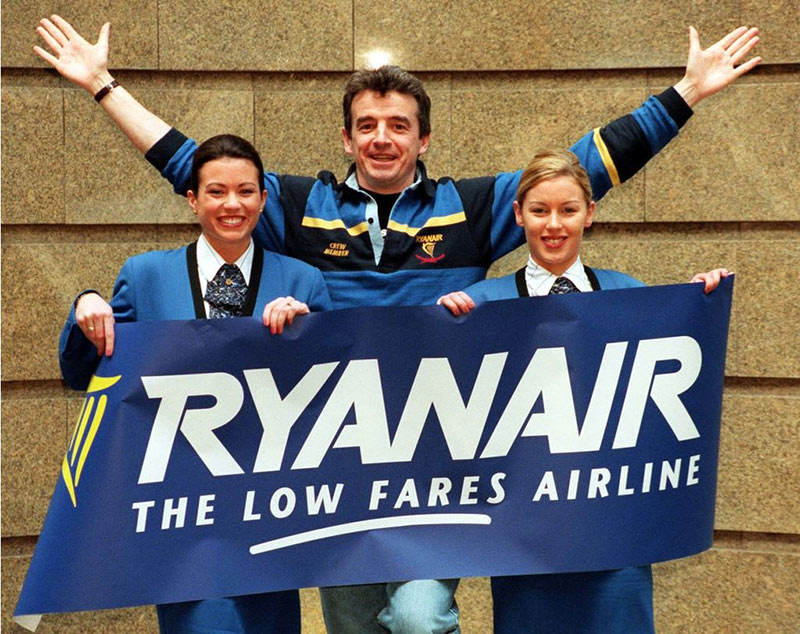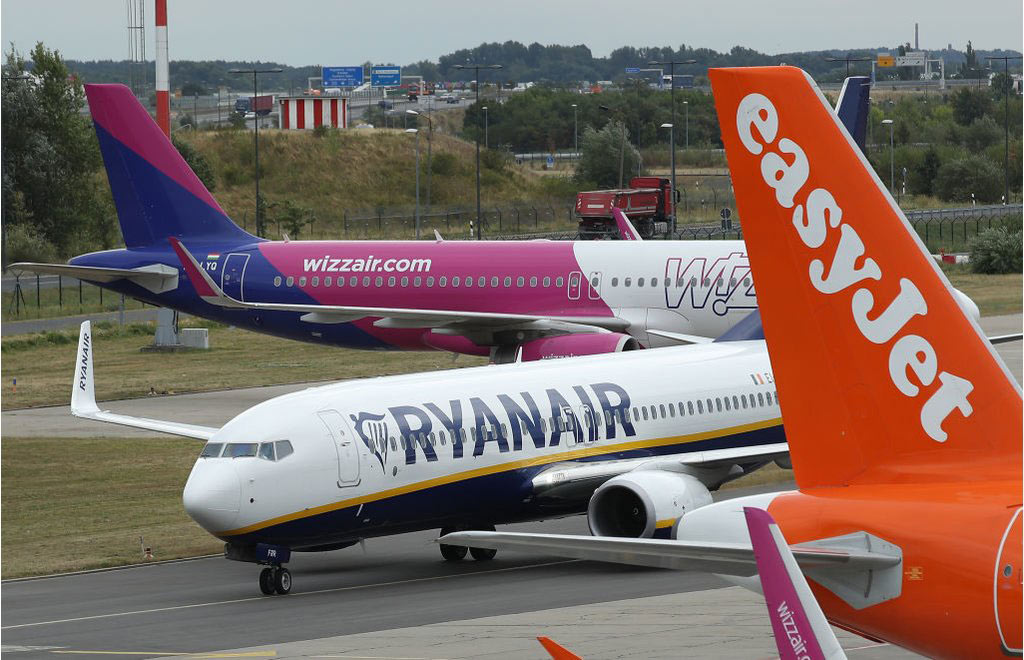歐洲廉價(jià)航空公司如今遭遇破產(chǎn)潮
|
1992年,美國見證了黑手黨約翰·戈蒂的審判,、總統(tǒng)比爾·克林頓的當(dāng)選以及颶風(fēng)安德魯在佛羅里達(dá)州海岸的毀滅性登陸,,其損失達(dá)到了創(chuàng)紀(jì)錄的250億美元。在美國本土之外,,查爾斯王子與戴安娜王妃也在當(dāng)年上演了一場舉世矚目的分手大戲,。
因此,像歐盟內(nèi)部航運(yùn)市場協(xié)議的制定這種不起眼的小事,,自然而然也就難以吸引多少眼球,。但該協(xié)議顛覆了歐洲的旅行市場,而且如今正在逐漸引發(fā)人們的再度關(guān)注,,因?yàn)樗鶐淼牧畠r(jià)航運(yùn)時(shí)代已經(jīng)開始謝幕,。
在內(nèi)部航運(yùn)市場創(chuàng)建之前,歐洲航空旅行產(chǎn)業(yè)分屬于一系列基本封閉,、各自為政的本土市場,,每一個(gè)市場由一家國有旗艦航空把持,例如英航或法航,。內(nèi)部市場的建立用一套單一的歐盟規(guī)定取代了零散的各國法規(guī),,并借此為這個(gè)競爭不激烈、高票價(jià)的環(huán)境注入了活力,。這套規(guī)定取消了對航空公司運(yùn)營航線,、票價(jià)和航次的限制。歐洲各大航空公司首次可以按照自己的意愿在任何機(jī)場起飛降落,并按照自身的情況來制定票價(jià),。
面向大眾的旅行
結(jié)果如何,?像愛爾蘭的瑞安航空和英國的易捷航空取消了一切非必要的服務(wù),并以這種低成本業(yè)務(wù)模式挺進(jìn)了新放開,、飛速擴(kuò)張的航空旅行市場,,大幅拉低了機(jī)票的票價(jià)。旅客無法享受到免費(fèi)食品,、機(jī)艙娛樂系統(tǒng),,也沒有商務(wù)艙可選。然而他們卻因此獲得了一項(xiàng)福利:以一種在以前看來絕不可能的方式來探索歐洲,。一家人從米蘭到巴黎的票價(jià)如今還不到1992年的十六分之一,。最低票價(jià)從此前的400歐元(約合450美元)跌至如今的25歐元(約合28美元)。
以前被看作是奢華體驗(yàn)的航空旅行最終被褪去了所有華麗的外衣,;曾經(jīng)為富有旅游者或享受優(yōu)厚待遇的商務(wù)差旅人士預(yù)留的航空旅行如今已變成了大路貨,。大批大批的歐洲人坐上了飛機(jī)。
歐洲境內(nèi)航空旅行產(chǎn)業(yè)規(guī)模自那之后翻了三番,,僅2017年的乘客數(shù)就突破了10億大關(guān),。航空運(yùn)輸行動(dòng)小組稱,航空旅行產(chǎn)業(yè)如今占到了歐盟就業(yè)總數(shù)的3.3%,,占?xì)W盟GDP的4.1%,。該產(chǎn)業(yè)提供了1220萬個(gè)就業(yè)崗位,其經(jīng)濟(jì)貢獻(xiàn)額達(dá)到了8230億美元,。 |
In 1992, the U.S. witnessed the trial of John Gotti, the election of President Bill Clinton and the devastating arrival of Hurricane Andrew on the Florida coastline, causing a then-record $25 billion in damage. Further afield, it was also the year that Prince Charles initiated the world’s most-watched break-up by separating from Princess Diana.
So, it’s only natural that the creation of something as obscure as the European Union’s Internal Market for Aviation went largely unnoticed. But the deal revolutionized travel in Europe and is now getting renewed attention as the era of cheap flights it ushered in begins to fade.
Prior to its creation, European air travel was split into a series of distinct, largely captive, domestic markets, each often dominated by a single state-owned national flag carrier such as British Airways or Air France. The Internal Market rejuvenated this low-competition, high-fare environment by replacing the patchwork of national regulations with a single set of EU rules that removed restrictions on the routes, fares, and flights that airlines could operate. For the first time ever, European airlines could fly in and out of any airport they wished and charge customers any price they wanted
Travel for the masses
The result? Plummeting flight prices as the likes of Ireland’s Ryanair and the U.K.’s easyJet stepped into the newly relaxed—and massively expanded—market with a low-cost business model that eliminated all non-essential services. Its fliers got no complimentary food, no in-flight entertainment, and had no option for business-class seating. What they did get, however, was the opportunity to explore Europe in a way never deemed possible before: a family trip from Milan to Paris now costs 16 times less than in 1992—with the minimum price of a ticket falling from over €400 ($450) to about €25 ($28) today.
The once luxurious experience of air travel was essentially stripped down to the studs; once reserved for the wealthy tourist or the well-looked-after business traveler, it was now downright accessible. And Europeans hopped onboard—by the hoards.
Intra-European air travel has tripled since then, with over a billion passengers marching down jet bridges in 2017 alone. Air travel now accounts for 3.3% of all EU employment and 4.1% of the bloc’s entire GDP, according to the Air Transport Action Group (ATAG). The aviation industry supports 12.2 million jobs and accounts for $823 billion in economic activity. |

|
難怪瑞安航空的首席執(zhí)行官邁克·歐利瑞在2017年慶祝公司成立25周年時(shí)將內(nèi)部航運(yùn)市場協(xié)議描述為“歐盟的杰出成就”。易捷航空的前任首席執(zhí)行官卡洛琳·邁卡爾在周年慶典時(shí)表示,,這一協(xié)議實(shí)現(xiàn)了大眾航空旅行的民主化,。
廉價(jià)航空公司的破產(chǎn)潮
盡管歐洲低成本航空公司在過去20年中取得了輝煌的業(yè)績,但該行業(yè)的上空也出現(xiàn)了越來越多的陰霾,。雖然瑞安和易捷占據(jù)了歐盟19%的航空市場,,但其他希望利用歐洲完全開放市場的低成本運(yùn)營商卻噩耗連連。
國際航空運(yùn)輸協(xié)會(huì)的首席經(jīng)濟(jì)學(xué)家布萊恩·皮爾斯表示:“運(yùn)營業(yè)績不佳的航空公司并不在少數(shù),?!?/p>
自2017年8月以來,多家廉價(jià)航空公司已經(jīng)淡出了人們的視線,,包括柏林航空,、Monarch、Primera,、Small Planet,、Azur,、Cobalt、VLM,、PrivatAir以及上個(gè)月倒閉的冰島航空公司W(wǎng)OW,。
與此同時(shí),傳聞要裁員的英國低成本航空公司弗萊比航空最近取消了十幾個(gè)航班,。該公司如今被重新命名為Connect Airways,,成為一家財(cái)團(tuán)的子公司,該財(cái)團(tuán)的成員包括維珍大西洋航空公司等,。意大利已破產(chǎn)旗艦航空公司意大利航空的命運(yùn)依然懸而未決,,斯洛文尼亞的亞得利亞航空亦是如此,。在斯洛文尼亞民航總局要求亞得利亞航空提供其財(cái)務(wù)穩(wěn)健性的證明之后,,該公司在去年12月的再融資額高達(dá)400萬歐元(約合450萬美元)。
那么,,航空民主化的遠(yuǎn)大理想緣何輝煌不再,?
“它們只不過是活不下去了”
皮爾斯說:“大多數(shù)破產(chǎn)的航空公司都是小公司,為什么破產(chǎn)的公司如此之多,,其原因在于歐洲航空公司實(shí)在是太多了,。大約有200家航空公司提供歐洲境內(nèi)的定期航班服務(wù)。如果看一下包括加拿大在內(nèi)的北美市場,,你會(huì)發(fā)現(xiàn)這個(gè)數(shù)字還不到100家,。”皮爾斯指出,,美國和加拿大80%的座位數(shù)僅由7大航空公司把控,,但在歐洲,同樣比例的座位數(shù)卻掌控在28家航空公司手中,。
歐洲航空產(chǎn)業(yè)的相對成功——2018年航班數(shù)量年增速達(dá)到了5.7%——激勵(lì)著航空公司通過增加班次和購買更大的機(jī)型來提供更多的座位,,其當(dāng)前的座位數(shù)增速甚至已經(jīng)超過了乘客的實(shí)際需求。
與此同時(shí),,由于薪資的上升以及全球燃油價(jià)格上漲20.5%,,航空公司在2018年的大部分時(shí)間里一直忙于控制成本的增加。與美國不同的是,,多家航空公司還選擇對其燃油合約進(jìn)行套期保值操作,,意味著它們不得不在燃油成本實(shí)際上較去年同期下跌3.2%的情況下繼續(xù)支付高額油價(jià)。
結(jié)果,,機(jī)票價(jià)格在這個(gè)成本不斷上升的時(shí)期越來越便宜,,這一現(xiàn)象對于一些低成本航空公司來說是致命的。
Frontier Economics的運(yùn)輸與水務(wù)總監(jiān)丹·伊利亞特說:“這些航空公司只不過是活不下去了,,因?yàn)槔麧櫬史浅5?,而且資金最后也耗盡了,。”
正是因?yàn)檫@個(gè)原因,,歐洲最受歡迎的航空公司都是那些財(cái)大氣粗,、對成本控制極度苛刻的公司。Scope Ratings稱,,瑞安,、易捷以及漢莎、國際聯(lián)合航空集團(tuán)(成員包括愛爾蘭航空,、英航,、伊比利亞航空和伏林航空)和法航荷航集團(tuán)這三大主流航空公司占據(jù)了2018年歐盟航空旅行50%的市場份額。
JLS Consulting的航空專家約翰·斯德里克蘭德說:“瑞安航空絕不放過任何一個(gè)討價(jià)還價(jià)的機(jī)會(huì),,而且連一刻都不敢放松警惕,,因?yàn)槟呐率呛娇杖加偷囊粋€(gè)微小變化,一旦乘以公司的用量,,就會(huì)立即變成一個(gè)天文數(shù)字,。”
成功的秘訣
然而這對于歐洲小規(guī)模廉價(jià)航空公司來說并非都是壞消息,。上周三,,新加入市場的匈牙利威茲航空(成立于2004年)宣布,公司截至今年3月31日最后一個(gè)財(cái)季的收入符合預(yù)期,,而且其凈利潤處于此前指引范圍2.7億歐元(約合3.03億美元)至3億歐元(約合3.36億美元)的上半?yún)^(qū)間,。公司股價(jià)應(yīng)聲上漲4.8%,推動(dòng)其市值達(dá)到了29億美元,。與瑞安和易捷一樣,,該航空公司通過在冬季推出12美元這樣的超低票價(jià),來應(yīng)對漫長的季節(jié)性低谷期,,并推動(dòng)附帶項(xiàng)目營收的增長,,例如行李寄放、租車和酒店預(yù)訂,。 |
No wonder Ryanair CEO Michael O’Leary described the Internal Market as “the stand-out achievement of the EU” in celebration of its 25th anniversary back in 2017. Former easyJet CEO Carolyn McCall said the deal “democratized air travel for all” on the same occasion.
Budget airlines go under
Despite the soaring success of low-cost aviation in Europe over the past two decades, ominous clouds have recently started to gather. While Ryanair and easyJet account for 19% of the EU aviation market, other low-cost carriers that sought to capitalize on Europe’s wide-open market have run out of runway.
“[T]here is a very long tail of poorly performing airlines,” says Brian Pearce, chief economist of the International Air Transport Association (IATA).
Since August 2017, the sector has waved goodbye to a string of discount airlines, including Air Berlin, Monarch, Primera, Small Planet, Azur, Cobalt, VLM, PrivatAir and Icelandic carrier WOW, which collapsed last month.
At the same time, British low-cost carrier Flybe—which recently canceled dozens of flights amid talk of jobs cuts—is currently being rebranded as Connect Airways under a consortium involving Virgin Atlantic. The fate of Italy’s bankrupt flag carrier Alitalia hangs in the balance—as does that of Slovenia’s Adria Airways, which was recapitalized to the tune of €4 million ($4.5 million) in December after the Civil Aviation Agency of Slovenia ordered it to provide evidence of its financial stability.
So, why is the dream of accessible air travel in Europe starting to dim?
‘They just get squeezed’
“The reason you’re seeing a series of failures—which are mostly smaller airlines—reflects the fact that Europe has an awful lot of airlines,” says Pearce. “There are something like 200 airlines offering scheduled services within Europe,” he says. “If you look at the North American market, including Canada, it’s less than 100.” Eighty percent of airline seats in the U.S. and Canada are supplied by just seven airlines; in Europe, it takes 28 airlines to supply the same number, according to Pearce.
The relative success of the European air industry—which recorded a 5.7% annual increase in flight traffic across 2018—has encouraged airlines to make more and more seats available through a combination of extra flights and larger aircraft, to the point that they have now run ahead of actual passenger demand.
At the same time, carriers had to budget for higher costs in much of 2018 due to increased wages and a 20.5% rise in global fuel prices. Unlike the U.S., a number of airlines also chose to hedge their fuel contracts, meaning they continue to pay higher prices at a time when fuel costs have actually dropped 3.2% compared to the equivalent period in 2018.
The result is that ticket prices have dropped, and in a period of rising costs, this has proved to be fatal for some low-cost carriers.
“They just get squeezed because the margins are very low, and they just run out of finance in the end, says Dan Elliott, Director in Transport and Water at Frontier Economics
It is for this reason that Europe’s most flown-on airlines are those that combine broad financial shoulders with a laser-like focus on costs. Together, Ryanair, easyJet and the big-three major network airlines Lufthansa, International Consolidated Airlines (Aer Lingus, British Airways, Iberia and Vueling), and Air France-KLM accounted for 50% of all EU air travel in 2018, according to Scope Ratings.
“Ryanair will negotiate on absolutely everything and they can’t afford to sleep for a second because even a minor change in the price of airline fuel, multiplied up over the amount of output they have suddenly becomes enormous,” says aviation expert John Strickland from JLS Consulting.
Secrets for success
Yet it’s not all bleak news for Europe’s smaller low-cost carriers. On last Wednesday, Hungarian newcomer Wizz Air, founded in 2004, announced that earnings in the final quarter of the year to March 31 had been in line with expectations and that net profit would be at the upper half of its previous guidance range of €270 million ($303 million) and €300 million ($336 million). Shares of Wizz Air rose by 4.8% on the news, valuing the company at about $2.9 billion. As with Ryanair and easyJet, the airline is able to handle the considerable seasonal troughs by selling winter flights for as little as $12 to drive ancillary revenue, such as bag checking, car hire, and hotel bookings. |

|
斯德里克蘭德說:“從某些方面來講,,這些座位將成為其他類目營收的催化劑,。瑞安自己也說過,它希望成為旅行行業(yè)的亞馬遜,。這個(gè)理念在于,,人們會(huì)登陸瑞安的網(wǎng)站,并預(yù)訂一切事物,,而不僅僅是航班,?!?/p>
問題在于,威茲在這一方面倒是一個(gè)例外,。國際航空運(yùn)輸協(xié)會(huì)估計(jì),,三大長途網(wǎng)絡(luò)航空公司如今貢獻(xiàn)了歐洲航空市場70%的運(yùn)營利潤,而剩余的30%則來自于威茲,、瑞安和易捷,,以及土耳其航空和俄羅斯航空這樣的中型航空公司。
國際航空運(yùn)輸協(xié)會(huì)在今年1月發(fā)布的經(jīng)濟(jì)報(bào)告稱,,“大量的中小型歐洲航空公司都在虧損或盈利甚微,。”
首席經(jīng)濟(jì)師皮爾斯說:“如果你將歐洲航空行業(yè)看作是一個(gè)整體,,那么它當(dāng)前的利潤實(shí)際上還是相當(dāng)可觀的,。問題在于,利潤的很大一部分都來自于那些大航空公司,?!保ㄘ?cái)富中文網(wǎng)) 譯者:馮豐 審校:夏林 |
“In some ways, the seats are becoming a catalyst to other revenues,” says Strickland. “Ryanair themselves have said that they want to become the Amazon of travel. The idea is that you go to the Ryanair website and book all sorts of things and not just flights.”
Problem is, Wizz is very much an exception to the rule. The IATA estimates that 70% of European operating profits are now being generated by the big-three long-haul network airlines, while much of the remaining 30% comes from Wizz, Ryanair and easyJet, plus medium-sized Turkish Airlines and Aeroflot.
“A significant number of smaller and medium-sized European airlines are loss-making or barely profitable,” states an IATA economics report released in January.
“If you look at the European airline industry in aggregate, it’s actually producing pretty good profits at the moment,” says chief economist Pearce. “The issue is that a large proportion of those profits are being produced by the big guys.” |













